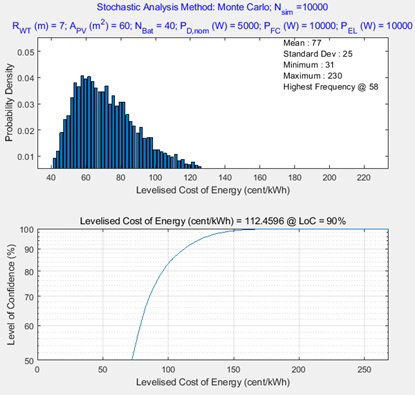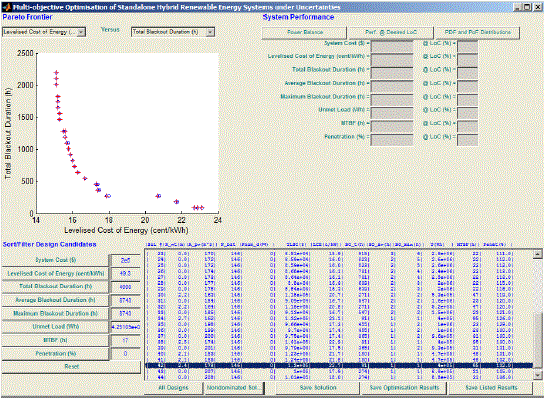A software tool for analysis and design optimisation of Hybrid Renewable Energy Systems
About MOHRES
MOHRES Main Features
- MOHRES conducts single and multi-objective size and configuration optimisation of standalone and on-grid hybrid renewable energy systems subject to uncertainties.
- MOHRES can deal with a generic hybrid configuration consisting of Wind, PV, Diesel, Battery, Fuel Cell and Electrolyser components.
- MOHRES employs innovative design and analysis methods and the state-of-the-art of optimisation technique.
- MOHRES is the only HRES design and analysis tool that
- predicts the performance of a HRES accurately and understandable by the end-user/customer,
- takes into account the end-user’s requirements in the end-user’s language,
- involves the customer in the design and selection process by providing them with a set of Pareto optimal solutions to select from through a simple and straightforward process,
- optimises dispatch strategy alongside with system size and configuration optimisations,
- takes into account the concept of flexible and plannable demand load.
Communities, energy consultancy, service provider and manufacturing companies have benefited from MOHRES read more
MOHRES for Analysis
MOHRES evaluates a hybrid renewable energy system against a wide range of traditional and new performance measures related to (i) cost/profit, (ii) reliability, and (iii) environmental impact:
- Total Lifespan Cost
- Levelised Cost of Energy
- Excess Power (Feed-In to Grid)
- Unmet Load
- Total, Average and Maximum Blackout (downtime) Duration
- Mean Time Between Failures
- Penetration
- CO2 Emission
The new reliability measures ‘Blackout Duration’ and ‘Mean Time Between Failures’ provide the end-user/customer a tangible means for understanding the reliability of the system.
| Traditional vs New Reliability Measures | Traditional reliability measures Not tangible to the end-user/customer |
New reliability measures Understandable by the end-user/customer |
| Example: | The system has a total yearly unmet load of 480 kWh (End-user/customer: What does it exactly mean? How good/bad is this?) |
System with total yearly downtime duration of 650 hours, average downtime duration of 2 hours, no downtime duration lasts more than 4 hours, and the average frequency of downtimes is 3 days. |
MOHRES, besides traditional deterministic analysis, conducts nondeterministic analysis to predict the performance of a HRES accurately.
 |
 LCE = 112.5 c/kWh @ Level of Confidence 90% |
| Deterministic vs Nondeterministic Analysis | Deterministic | Nondeterministic |
| Example: | Return of investment in 4 to 6 years (Inaccurate & misleading losing trust of customer) |
Return of investment in 5 years and 10 months @ a level of confidence of 90% (Accurate, understandable by the end-user/customer) |
MOHRES, where applicable, finds the best planned load for industrial applications with flexible loading
. Flexible Plannable Load for Industrial Applications |
MOHRES for Design
MOHRES employs a variety of single and multiobjective, heuristic and metaheuristic optimisation techniques, specially developed for HRES design space.
 Pareto Front Multiobjective Optimisation |
MOHRES conducts integrated configuration and size optimisation. Some possible HRES configurations with wind turbine, PV panel, battery bank, diesel generator and fuel cell/electrolyser:
| Traditional Approach | Integrated configuration and size optimisation (MOHRES) |
| Find the optimum component size for each possible configuration and then compare all optimum solutions against each other to find the best configuration. This can lead to solving 20 optimisation problems for a generic wind turbine, PV panel, battery bank, diesel generator and fuel cell/electrolyser system. | Integrate the configuration optimisation and size optimisation together and conduct only one optimisation problem to find the best configuration and the best size of components for that configuration. |
MOHRES employs a flexible problem formulation which allows conducting retrofitting of existing systems and defining energy transition scenarios.
MOHRES brings system operation & control into size optimisation by the inclusion of Dispatch Strategy at the design stage. This allows finding superior solutions compared to those obtained using traditional optimisation formulation:

